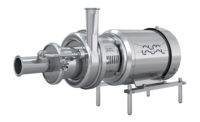Common stabilizers used in ice cream, such as guar gum, carob bean gum and cellulose gum, function to reduce the degree of ice crystal growth by influencing viscosity and other rheological properties, thus limiting the mobility of water in the unfrozen aqueous portion. This effect increases when the influence of freeze concentration further enhances the effects of stabilizers on viscosity.
At a point referred to as the “break point,” the degree of concentration can cause stabilizer and, possibly, other water-soluble compounds, to interact with each other, sometimes irreversibly, thus markedly increasing the effect on water mobility. It is also conceivable that this phenomenon combined with the extreme freeze concentration that occurs at low frozen storage temperatures can produce other interactions between individual water-soluble compounds.
Ice crystal growth
Control of ice crystal growth by stabilizers is related to influencing the mechanism of recrystallization during heat shock. Stabilizer functionality also controls ice crystal growth by managing ripening that occurs during early stages of hardening and situations during storage and distribution, when the product is exposed to relatively high temperatures (e.g. +10 to +18 F). In this range, the degree of freeze concentration is low, producing relatively low viscosity in the unfrozen portion.
This low viscosity allows for water to migrate from small to large ice crystals, increasing the average ice crystal size. Nevertheless, the influence of stabilizers on water mobility can have a useful effect on minimizing this ripening effect at any level of freeze concentration. A similar phenomenon occurs with regard to the control of the size of air bubbles, which can grow through the process of disproportionation.
Thus, the rheological effects of stabilizers are particularly important in stabilizing many desirable properties of the finished ice cream related to the mobility of water in the unfrozen system.
High viscosity can limit the temperature at which ice cream can be withdrawn and handled from the barrel of the ice cream freezer. When this happens, the amount of water frozen in the freezer is reduced. This has undesirable effects on the resistance of the ice cream to heat shock.
Low-viscosity gums may have more functionality in ice cream than previously thought. Low-viscosity stabilizers have not traditionally been used in ice cream because of an assumed lack of influence on water mobility.
The evolution of stabilizers
Some 40 years ago, as higher-than-normal levels of low DE corn syrups were used to balance the freezing point depression of newly developed high-fructose corn syrups, surprising resistance to heat shock resulted.
Twenty years ago, hydrolyzed, low-viscosity guar gum was found to control ice crystal growth comparable to conventional, high-viscosity guar while maintaining desirable sensory properties. More recently, low-viscosity gum acacia has been used.
It is possible that low-viscosity carbohydrates with high molecular weights and more complex structures can contribute useful stabilizer-like functionality because of irreversible phenomena as a result of extreme freeze concentration that occurs at very low temperatures. Such effects might provide significant advantages over high-viscosity stabilizer systems, including:
- Economies related to the cost of heat transfer and mix transport.
- Facilitating the achievement of lower draw temperatures (not inherently due to freezing point depression) and the resulting positive effect on having more and smaller ice crystals formed in the barrel of the freezer.
- Colder draw temperatures could also enhance beneficial effects of fat agglomeration.
- Possible tolerance to the freezing point depression effect of low molecular weight sweeteners.
- Allowing for mix compositions/mix densities that inherently allow for significant yield improvements via added tolerance to slightly higher overruns.
- Potential ingredient cost reductions from partial replacement of other mix ingredients.
The functionality of traditional high-viscosity gums and other ingredients will continue to be relevant, and will be difficult to replace in products such as soft serve, direct draw shakes, water ices and sorbets.
As always, form and function meet to deliver ultimate sensory appeal.
Learn more at the Las Vegas seminar
For more on the utility of low-viscosity polysaccharides to stabilize ice cream, plan to attend the 35th Edition of “Tharp & Young On Ice Cream Technical Short Course, Workshops, and Clinics”, Dec. 4 to 6, Las Vegas. For more, go to www.onicecream.com, or call 610-975-4424 or 281-782-4536.



